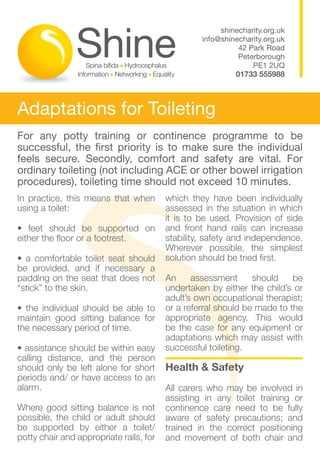
Adaptations for toileting
- 1. shinecharity.org.uk info@shinecharity.org.uk 42 Park Road Peterborough PE1 2UQ 01733 555988 Adaptations for Toileting For any potty training or continence programme to be successful, the first priority is to make sure the individual feels secure. Secondly, comfort and safety are vital. For ordinary toileting (not including ACE or other bowel irrigation procedures), toileting time should not exceed 10 minutes. In practice, this means that when which they have been individually using a toilet: assessed in the situation in which it is to be used. Provision of side • feet should be supported on and front hand rails can increase either the floor or a footrest. stability, safety and independence. Wherever possible, the simplest • a comfortable toilet seat should solution should be tried first. be provided, and if necessary a padding on the seat that does not An assessment should be “stick” to the skin. undertaken by either the child’s or adult’s own occupational therapist; • the individual should be able to or a referral should be made to the maintain good sitting balance for appropriate agency. This would the necessary period of time. be the case for any equipment or adaptations which may assist with • assistance should be within easy successful toileting. calling distance, and the person should only be left alone for short Health & Safety periods and/ or have access to an alarm. All carers who may be involved in assisting in any toilet training or Where good sitting balance is not continence care need to be fully possible, the child or adult should aware of safety precautions; and be supported by either a toilet/ trained in the correct positioning potty chair and appropriate rails, for and movement of both chair and
- 2. individual. This should include both continence, and to encourage voluntary and employed carers. independence. Wherever possible they should be tried out in situ, in Many toilet/shower chairs have the presence of an occupational parts, including removable seat therapist. If an item is to be and castors that are necessary, purchased privately, because of but can be hazardous. Therefore the waiting list for assessment, it all equipment should be checked should at least be viewed, before regularly. costly provision is made. Moving and handling guidelines Most areas now have Disabled and regulations require that many Living Centres where members of service users and their carers use the public can receive professional hoists. LOLER (Lifting Operations advice from occupational therapists and Lifting Equipment Regulations) and view or try out equipment. governs the use and care of all Often an appointment is required. lifting equipment: existing, second- It is essential that the limitations of hand, leased or new. LOLER states that all equipment and accessories the service user’s own bathroom or used to lift people must be serviced toilet, be made clear and taken into every 6 months. consideration. For example, most shower chairs require as much Equipment doorway width as a wheelchair and will need to be stored somewhere There is a vast array of equipment when not in use. available to assist with toileting and Help us Shine relies on people’s generosity and support so we can help our clients who depend on us for help and advice - people with hydrocephalus, spina bifida, their families and carers. To donate to Shine please visit www.shinecharity.org.uk or call 01733 421329. This information has been produced by Shine’s medical advisers and approved by Shine’s Medical Advisory Committee of senior medical professionals. Shine - Registered charity no.249338 To see our full range of information sheets and to find out how to donate to Shine please visit www.shinecharity.org.uk
